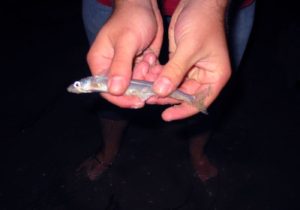Submitted by Ann Boyd

Grunion runs are unique spectacles found nowhere in the world except in Southern California, from the Santa Barbara shores down to the northern beaches of Baja California. These small, silvery fish come ashore to mate in the most unusual act of mating never dreamed of by any other species! Persnickety about where they will have their astounding mating ritual, they are also picky as to when. For starters, June, July and August are your best months for hitting the beach. They spawn, starting in March, but the law designates you shall not hunt then. Nor will you legally help yourself to these mini mouthfuls in April and May. Poles, nets, and hooks are not allowed – just hands are permitted. So, now is the time! But keep in mind, a license is required if you want to catch them for your use; however, they are so small (6” or less) and boney, it’s hardly worth the effort to catch and cook them.
Where to find grunion is a lesson in humility. They don’t come in at just any old beach. Nor at any old time. The runs are tied to the high tides of full and new moons. The third and fourth nights after these moons will reward you, if you know the time of the high tide. That’s when the female comes ashore and burrows her tail into the sand and deposits her eggs. But she is not alone for very long, because the males proceed to swim around the mothers-to-be, depositing their sperm, which seeps into the sand, fertilizing the buried eggs. The females and males then are carried back out to sea and the eggs will remain buried until the next high tide, at which time the tiny babies are washed out to sea, a procedure we don’t get to see.
“Location, location, location” is well respected by grunion. They crave the quiet and the dark. They will not come up on the beach if there are beach fires; and if people are walking up and down the beach, talking, and yelling and waving their flashlights before time for the high tide. These activities will scare the fish away. Yes, as unbelievable as this seems, it’s true. But once the mating frenzy has started, (around 15 minutes after the time of the actual high tide), feel free to approach them. The orgy will continue for about 2 hours. Let me emphasize the need for a dark and quiet beach. How about the Silver Strand? May your patience reward you!
Ann Boyd





